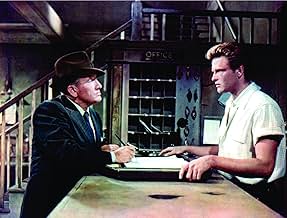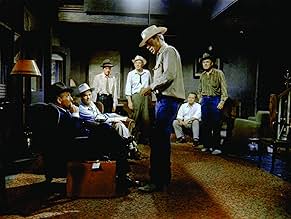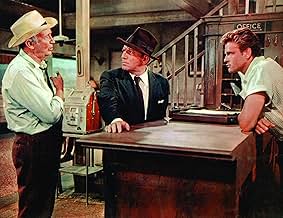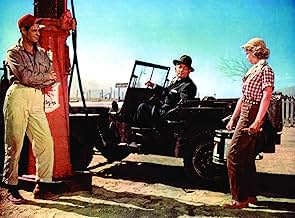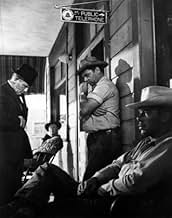एक-हाथ वाला अजनबी एक छोटे से शहर में आता है जिसमें एक भयानक अतीत है जिसे वहां के लोग हिंसा या किसी भी तरीके से गुप्त रखना चाहते हैं.एक-हाथ वाला अजनबी एक छोटे से शहर में आता है जिसमें एक भयानक अतीत है जिसे वहां के लोग हिंसा या किसी भी तरीके से गुप्त रखना चाहते हैं.एक-हाथ वाला अजनबी एक छोटे से शहर में आता है जिसमें एक भयानक अतीत है जिसे वहां के लोग हिंसा या किसी भी तरीके से गुप्त रखना चाहते हैं.
- निर्देशक
- लेखक
- स्टार
- 3 ऑस्कर के लिए नामांकित
- 4 जीत और कुल 8 नामांकन
- Cafe Lounger
- (अपुष्टिकृत)
- Cafe Lounger
- (अपुष्टिकृत)
- Cafe Lounger
- (अपुष्टिकृत)
- Cafe Lounger
- (अपुष्टिकृत)
- Second Train Conductor
- (बिना क्रेडिट के)
- First Train Conductor
- (बिना क्रेडिट के)
- One of Two Porters
- (बिना क्रेडिट के)
- Tall - White-haired Cafe Lounger
- (बिना क्रेडिट के)
फ़ीचर्ड समीक्षाएं
I read a review of the film on IMDB pointing out the flaws in the script. They are all correct, if we go by rational thinking. But the merits of this film are the superb editing, the beautiful cinemascope photography and the arresting performances. Every time I see this film I am reminded of Spielberg's little known film "Duel" that had similar thrilling tension packed into less than 24 hours of screen time--a film I admire much more as good cinema than the recent box office outputs of Spielberg.
Compare this film with Sturges' "The Magnificent Seven." Sturges like King Vidor, seemed to pick up stories to film that looked at the oppressed and tried to present a world that could be better. "The Magnificent Seven," like this film, had a predominantly male cast. It appealed to most viewers. And some could see a social and even a political layer beneath these films.
What I find most appealing is the the ability of Sturges, Vidor, and the early unsung Spielberg's ability to use cinema to combine thrills, human values and craft in say 81 minutes as in this film. Spencer Tracy is not to be admired for the way he delivers his lines, but his body movements which remind you of majestic caged animal that can be deadly if provoked. Sturges brings to the fore evil in different ways--the dead buck strapped on the front of a vehicle, menace on empty roads by big vehicles (used in "Duel" to great effect), evil women when you expect them to be good, laws used in illegal ways (the hotel registration scene), etc. Sergio Leone made similar films in Europe--the famous spaghetti westerns--with laconic dialogues and emphasis on body movements and photography
In spite of its flaws, it is a film Hollywood can be proud of. I only hope TV reruns show the film in its original cinemascope grandeur, which grabbed me the first time I saw it decades ago.
Unity of place:everything takes place in a one-horse town,Black Rock,where an unusually inventive use of the wide screen makes the small town even more isolated,cut off from the world.When you leave Black Rock,you find a desolate landscape where only some flowers (of death?as Tracy points out)grow.
Unity of action:something happened in "Black Rock" ,something that its inhabitants are anxious that it remains in the shadow.Enter Tracy who seems to know too many things he should.Then all the inhabitants all stand together ,and their conspiracy of silence becomes threatening.What's amazing is that John Sturges (it's probably his best film,he uses Tracy in a much better way than he did in "people against o'Hara" some years before)refuses the easy way out:take for instance the only female character played by Anne Francis ;she does not act as the audience expects .Stand-out remains Robert Ryan,always excellent in one of his villains parts:funny how an actor who was known for his liberal views should have played so many racists ,anti-Semitics (this film,but also Dmytryk's "crossfire" and Wise's "against all odds").Other good performances come from Marvin and Borgnine.
Unity of time:everything happens in the space of 24 hours;first sequence :the train arrives in Black Rock,last sequence:it leaves it.
This is a modern western,which takes place just after WW2."Bad Day at Black Rock" is also,in its own special way, a war movie ,and also an anti-war one,because Tracy's life was saved by a...
Thoroughly enjoyable ,it deserves its reputation of classic.
A classy production that combines elements of Westerns and film noir, Bad Day at Black Rock deals with racism and all the hate and bully tactics that come with such a vile subject. It tells the story of a mysterious one armed stranger, John J. Macreedy (Tracy), who arrives at a tiny isolated town in a desert of the Southwest United States in search of a Japanese-American man. From the moment he arrives he is met with hostility and mistrust. Over the course of the day Macreedy picks apart the town to uncover the secret that the towns folk had hoped had gone away forever.
From the opening sequence of a bright red train rushing towards us, it's evident that we are in the modern day West. It's just after World War II and the horse trails of the old West are now frequented by jeeps and cars. Yet the hallmarks of the old West exists and thrives because of the inhabitants of Black Rock. An ignorant group of people consisting of bullies, drunks and the head in the sand weak willed type. Yet even though the film is set mostly in the blazing sun, in a barren one horse Western town that time forgot, the film exudes a film noir sensibility. Dark secrets from the past weigh heavy on the shoulders of the towns' big players - and Tracy's High Noon like situation is moodily paced by the wily Sturges. In fact, that a film with so little "gun play" action can be so tense is actually no mean feat, with him yet again directing an ensemble cast to great effect.
Tracy is at his best when he is as he is here, playing subdued. Here he is a thinking man's protagonist, calm and reflective in the face of constant hostility. That he is facing an impressive line up of heavies really brings home just how thoughtful a performance Tracy gives in the piece. Robert Ryan does yet another fine turn as a complicated villain whose rage is bubbling away under the surface. Borgnine and Marvin are memorably vile as his right hand thugs, Dean Jagger as the drunken cowardly sheriff manages to pang the heart and Walter Brennan is his usual solid scene influencing self. Anne Francis adds the glamour but really - and sadly - it's a nondescript role that the film could easily have survived without.
Clocking in at just 81 minutes the film never outstays its welcome. It looks great on home format issue, and for those interested in commentary tracks, this one comes with a very good one from Dana Polan. Anyone who has not seen this film should try and seek it out. It was considered controversial back on release but now can be viewed as a smart message movie about racial tolerance. Tight, taut and expertly directed and acted, Bad Day At Black Rock is an important film from the 50s that still rings the bells loudly even today. 8/10
क्या आपको पता है
- ट्रिवियाJohn Sturges had already moved on to his next film, The Scarlet Coat (1955), so Herman Hoffman took charge of filming the opening. The plan was to shoot the train hurtling toward the audience, almost like a 3-D movie, but it would have been deadly to attempt a helicopter maneuver into the path of a speeding locomotive. Stunt flier Paul Mantz offered the perfect solution: have the train running backwards, fly the copter over the retreating engine, then project the footage in reverse. "It's a helluva shot," Sturges later said, "but I didn't make it."
- गूफ़As the train approaches the town, the horn blows twice, which is the signal for starting up. The mandatory signal for a grade crossing (long, long, short, long) is never blown, although one clearly exists. When the train departs, the conductor makes a confused hand signal to the engineer resembling the horizontal motion that means "stop" rather than the vertical motion that means "go". The engineer never responds with the "long, long" starting signal.
- भाव
Reno Smith: I swear, you're beginning to make me mad.
John J. Macreedy: All strangers do, hmm?
Reno Smith: No, they don't. Not all of them. Some do, when they come around snooping...
John J. Macreedy: Snooping for what?
Reno Smith: I don't know, outsiders coming in, looking for something...
John J. Macreedy: Looking for what?
Reno Smith: I don't know! Somebody's always looking for something in this part of the West. To the historian it's the Old West, to the book writer it's the Wild West, to the businessman it's the Undeveloped West -- they say we're all poor and backward, and I guess we are, we don't even have enough water. But to us, this place is *our* West, and I wish they'd leave us alone!
John J. Macreedy: Leave you alone to do what?
Reno Smith: I don't know what you mean.
- इसके अलावा अन्य वर्जनTo receive an 'A' (PG) certificate in 1955 the UK cinema version was subject to heavy BBFC cuts. These included Macreedy striking Hector with the brass fire hose nozzle and the climactic shots of Reno on fire. Later TV showings and video releases were fully uncut.
- कनेक्शनFeatured in The Spencer Tracy Legacy: A Tribute by Katharine Hepburn (1986)
टॉप पसंद
विवरण
बॉक्स ऑफ़िस
- बजट
- $12,71,000(अनुमानित)
- दुनिया भर में सकल
- $10,813
- चलने की अवधि
- 1 घं 21 मि(81 min)
- रंग
- पक्ष अनुपात
- 2.35 : 1


